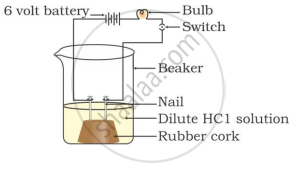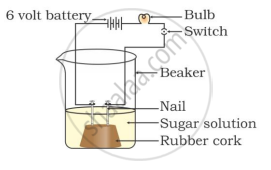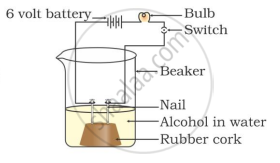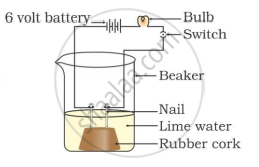Advertisements
Advertisements
प्रश्न
While diluting an acid, why is it recommended that the acid should be added to water and not water to the acid?
उत्तर १
Since the process of dissolving an acid in water is exothermic, it is always recommended that acid should be added to water. If it is done the other way, then it is possible that because of the large amount of heat generated, the mixture splashes out and causes burns.
उत्तर २
- Diluting is a process that involves adding concentrated acid to the water. The concentrated water will be added gradually by stirring.
- There is heat that is evolved slowly and gradually so that concentrated acid is added because diluting acid easily absorbs large quantity of water.
- If it happens in the other way by adding water to diluted acid the amount of heat evolved is all don’t at once and not gradually. This may cause a splash and could end up in acid burn.
APPEARS IN
संबंधित प्रश्न
Why do acids not show acidic behaviour in the absence of water?
What colour do the following indicators turn when added to a base or alkali (such as sodium hydroxide)?
red cabbage extract
What colours do the following indicators turn when added to an acid (such as hydrochloric acid)?
methyl orange
Which gas is liberated when dilute hydrochloric acid reacts with sodium carbonate?
How will you test for the presence of this gas?
What happens when carbon dioxide gas is passed through lime water for a short time?
Write equations of the reactions involved.
You have been provided with three test-bubes. One of these test-tubes contains distilled water and the other two contain an acidic and a basic solution respectively. If you are given only blue litmus paper, how will you identify the contents of each test-tube?
What is common in all the water soluble bases (or alkalis)?
What is meant by strong bases and weak bases? Classify the following into strong bases and weak bases:
NH4OH, Ca(OH)2, NaOH, KOH, Mg(OH)2
What happens when carbon dioxide gas is passed through lime water for a considerable time ?
Write equations of the reactions involved.
Choose the correct option from given alternative:
When a small amount of acid is added to water, the phenomena which occur are:
(A) Dilution
(B) Neutralization
(C) Formation of H3O+ ions
(D) Salt formation
Answer the following question.
Blue litmus solution is added to two test tubes A and B containing dilute HCl and NaOH solution respectively. In which test tube a colour change will be observed? State the colour change and give its reason.
In the experimental set-up to show that "the germinating seeds give out carbon dioxide", answer the following questions:
(i) Why do we keep the conical flask airtight?
(ii) Name the substance kept in the small test tube inside the conical flask. Write its role.
(iii) Why does water rise in the delivery tube?
In which of the following setups would the bulb glow?
Which of the following phenomena occur when a small amount of acid is added to water?
- Ionisation
- Neutralisation
- Dilution
- Salt formation
Salt A commonly used in bakery products on heating gets converted into another salt B which itself is used for the removal of hardness of water and a gas C is evolved. The gas C when passed through lime water, turns it milky. Identify A, B and C.
A metal carbonate X on reacting with an acid gives a gas which when passed through a solution Y gives the carbonate back. On the other hand, a gas G that is obtained at anode during electrolysis of brine is passed on dry Y, It gives a compound Z, used for disinfecting drinking water. Identity X, Y, G and Z.




